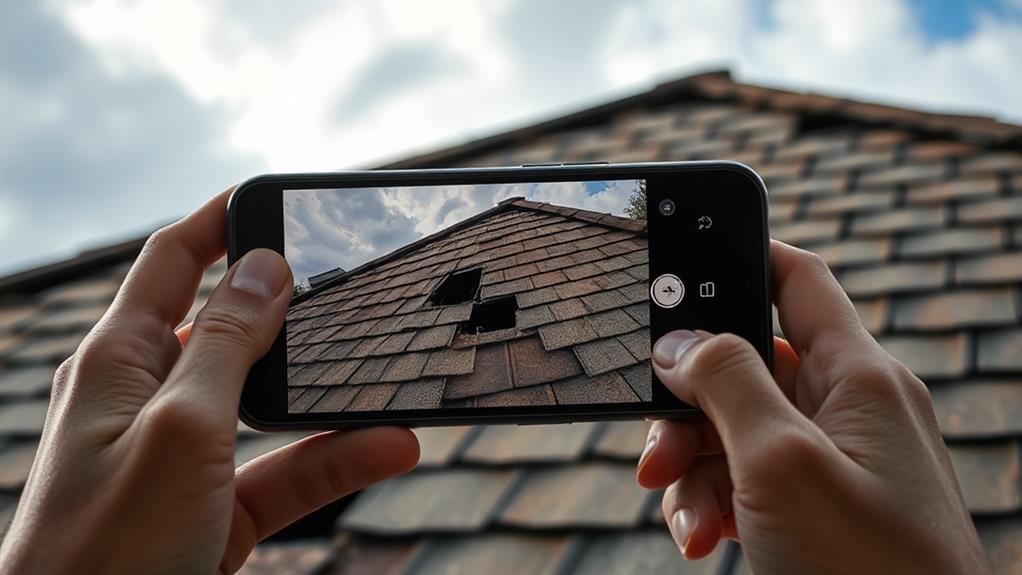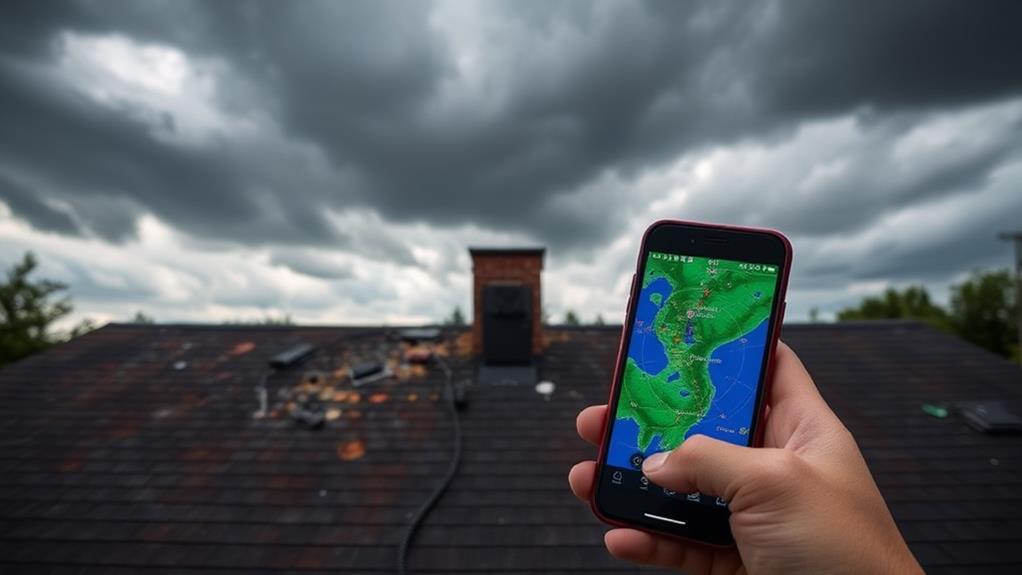Documenting roof damage effectively strengthens insurance claims. Start by safely assessing the damage, using binoculars or drones for initial inspection. Take comprehensive photographs and videos, capturing wide-angle shots and close-ups of specific issues. Keep detailed written notes, including dates, weather conditions, and repair activities. Gather official weather reports to corroborate your claim. Document any temporary repairs made to mitigate further damage. Obtain professional inspection reports from licensed contractors or certified inspectors. Organize all evidence, including receipts and correspondence, into a comprehensive claim file. Following these steps ensures a thorough documentation process, increasing the likelihood of a successful claim.
Assess the Damage Safely

Before attempting any roof inspection, prioritize safety above all else. Never climb onto a damaged roof, as it may be structurally compromised. Instead, conduct a preliminary assessment from the ground using binoculars or a drone with a high-resolution camera. Look for obvious signs of damage such as missing shingles, dented metal panels, or visible holes.
If it's necessary to get a closer look, use a sturdy ladder placed on level ground, extending at least three feet above the roof's edge. Wear non-slip shoes and consider using a safety harness. Avoid inspections during wet, windy, or icy conditions. Be aware of potential hazards like power lines or unstable debris.
For a thorough professional assessment, contact a licensed roofing contractor or a certified insurance adjuster. These experts have the necessary equipment and training to safely navigate and evaluate roof damage. They can provide detailed reports and estimates, which are invaluable for insurance claims. Remember, documenting damage is important, but personal safety should always be the top priority when dealing with roof-related issues.
Take Comprehensive Photographs
Comprehensive photographic documentation is crucial when recording roof damage. Begin by capturing wide-angle shots of the entire roof from multiple angles, ensuring all affected areas are visible. Then, systematically photograph each damaged section up close, focusing on specific issues like missing shingles, cracks, or punctures. Include clear images of any debris that may have caused the damage.
Document interior damage as well, such as water stains on ceilings or walls, which can indicate roof leaks. Take photos of attic spaces, paying attention to wet insulation or visible sunlight through the roof. Use a ruler or other common object in some photos to provide scale, helping adjusters gauge the extent of the damage.
Ensure proper lighting and focus for all images. If possible, use a high-resolution camera or smartphone with HDR capabilities. Organize your photos systematically, labeling them with date, time, and location within the property. Consider creating a simple diagram of your roof, marking damaged areas and corresponding photo numbers for easy reference. This thorough approach will strengthen your insurance claim and facilitate a smoother assessment process.
Record Video Evidence

Video documentation serves as a powerful complement to still photographs when recording roof damage. Unlike static images, videos capture a continuous, dynamic view of the roof's condition, allowing for a more comprehensive assessment.
When recording, start with a panoramic shot of the entire roof, then zoom in on specific areas of damage. Narrate the video, describing the location, extent, and nature of each damaged area while filming.
Use a steady hand or tripod to ensure clear footage, and maintain good lighting conditions for optimal visibility. Walk around the roof's perimeter, if safe to do so, to document damage from multiple angles. Include close-ups of individual shingles, flashing, vents, and any other affected components. Capture footage of water stains, mold growth, or other signs of leaks inside the attic or upper floors.
Record the date and time of the video, and include a reference object for scale when possible. This additional context can prove invaluable when presenting evidence to insurance adjusters or roofing professionals. Store the video securely and create backups to prevent loss of this crucial documentation.
Keep Detailed Written Notes
Maintaining meticulous written notes is a crucial component of documenting roof damage. These notes serve as a comprehensive record of the incident and support your insurance claim.
Begin by recording the date and time of the damage, along with the weather conditions that may have contributed to it. Describe the extent and nature of the damage in detail, including specific areas affected, materials damaged, and any visible signs of water infiltration.
Note any immediate actions taken to mitigate further damage, such as covering exposed areas with tarps. Document conversations with insurance adjusters, contractors, or other professionals involved in assessing or repairing the damage. Include their names, contact information, and key points discussed.
Keep a chronological log of all repair-related activities, including estimates received, materials purchased, and work performed. Be sure to retain all receipts and invoices related to temporary repairs or replacements. These written notes, when combined with photographic and video evidence, create a robust documentation package that strengthens your insurance claim and helps ensure fair compensation for your roof damage.
Gather Weather Reports

Collecting weather reports is a critical step in documenting roof damage. These reports provide objective evidence of severe weather events that may have caused or contributed to the damage. Obtain official reports from reputable sources such as the National Weather Service, local meteorological stations, or accredited weather reporting agencies.
Focus on gathering data specific to your property's location and the date of the suspected damage. Key information to collect includes wind speeds, hail size, rainfall amounts, and any severe weather warnings issued. Pay particular attention to reports of microbursts, tornadoes, or other extreme weather phenomena that could have impacted your roof.
Include both historical weather data and real-time reports from the day of the incident. If possible, obtain satellite imagery or radar maps showing storm patterns over your area. These visual representations can strengthen your claim by illustrating the severity and path of the weather system.
Keep all weather reports organized chronologically and cross-reference them with your personal observations and photographs. This comprehensive approach creates a robust narrative of the events leading to your roof damage, bolstering your insurance claim's credibility.
Document Temporary Repairs
When temporary repairs are necessary to prevent further damage, how should you document these crucial interventions? Start by taking clear, date-stamped photographs of the damaged area before any repairs are made. Then, capture images during the repair process and after completion. These visual records provide a chronological account of the damage and your efforts to mitigate further issues.
Keep all receipts for materials used in temporary repairs, as well as invoices for any professional services. Create a detailed log of all repair activities, including dates, times, and descriptions of work performed. If possible, have an independent witness observe and sign off on your temporary repair efforts.
Video documentation can also be valuable. Record a brief explanation of the damage and the temporary measures taken, highlighting why they were necessary. Always prioritize safety when conducting or documenting repairs. If the damage is severe, consult with professionals before attempting any fixes.
Lastly, inform your insurance company promptly about the temporary repairs. Provide them with copies of your documentation, demonstrating your proactive approach to minimizing further damage. This thorough documentation strengthens your insurance claim and helps ensure fair compensation for your efforts.
Obtain Professional Inspection Reports

While temporary repairs are important, professional inspection reports provide a comprehensive assessment of roof damage. These reports, conducted by licensed roofing contractors or certified inspectors, offer an unbiased evaluation of the roof's condition and the extent of damage. They typically include detailed descriptions of visible damage, potential hidden issues, and recommendations for repairs or replacement.
To obtain a professional inspection report, contact reputable roofing companies or certified inspectors in your area. Schedule inspections as soon as possible after discovering damage to ensure accurate documentation. During the inspection, the professional will thoroughly examine the roof's structure, shingles, flashing, gutters, and underlying components. They may use specialized equipment like moisture meters or thermal imaging cameras to detect hidden water damage or insulation issues.
The resulting report should include photographs, diagrams, and written explanations of all identified problems. This document serves as crucial evidence for insurance claims, providing a credible, third-party assessment of the damage. It can also help prioritize necessary repairs and estimate costs, ensuring a more accurate and comprehensive insurance claim.
Organize Your Claim File
To effectively manage your roof damage claim, organizing a comprehensive claim file is essential. Begin by creating a dedicated folder or digital file to store all relevant documents. Include a chronological log of events, detailing every interaction with your insurance company, contractors, and inspectors. Record dates, times, names, and summaries of conversations.
Compile all photographs and videos of the damage, ensuring they are clearly labeled and dated. Store original receipts for any emergency repairs or temporary accommodations. Include copies of your insurance policy, claim forms, and any correspondence with your insurer. Organize professional inspection reports, cost estimates, and repair proposals from contractors.
Create a section for notes on local building codes and permit requirements. Keep a record of any weather reports or news articles related to the event that caused the damage. Maintain a separate list of personal property items affected by the roof damage, including descriptions and estimated values. Finally, include a summary sheet outlining key claim details, policy information, and important contact numbers. This organized approach will streamline the claims process and strengthen your position when negotiating with your insurance company.
Frequently Asked Questions
How Long Do I Have to File a Roof Damage Claim?
The timeframe for filing a roof damage claim varies by insurance provider and policy terms. Generally, it's advisable to file as soon as possible, often within 30 to 60 days of the damage occurring. Check your specific policy for details.
Will Filing a Roof Damage Claim Increase My Insurance Premiums?
Like a double-edged sword, filing a roof damage claim can potentially increase your insurance premiums. However, this isn't always the case. Factors such as claim history, policy type, and damage severity influence premium adjustments.
Can I Choose My Own Contractor for Roof Repairs?
Generally, you can choose your own contractor for roof repairs. However, it's advisable to check with your insurance company first, as they may have preferred vendors or specific requirements for contractor selection and claim processing.
What if My Insurance Company Denies My Roof Damage Claim?
Coincidentally, many homeowners face claim denials. If your insurance company denies your roof damage claim, you can:
- Request a detailed explanation
- Seek a second inspection
- File an appeal
- Consider hiring a public adjuster
Are There Specific Roofing Materials That Are More Likely to Be Covered?
Insurance coverage for roofing materials typically depends on your specific policy. However, standard materials like asphalt shingles, metal, and tile are commonly covered. Impact-resistant or weather-resistant materials may also be favored by insurers due to their durability.
Conclusion
Thorough documentation is crucial for successful roof damage insurance claims. A homeowner in Florida who meticulously photographed and cataloged hurricane damage, including before-and-after comparisons, secured a settlement 40% higher than initially offered. By systematically following the outlined steps, claimants can build a compelling case that accurately represents the extent of damage. This comprehensive approach not only expedites the claims process but also increases the likelihood of fair compensation, ensuring proper restoration of the damaged property.

